Adenocarcinoma of the Lung
Clincial History
This is a 76-year-old male with past medical history of prostate cancer (2005) for which he received external beam radiotherapy. He has been doing well since that time, without symptoms. The patient’s most recent PSA level was 0.2.
The patient also has history of right upper lobe lung cancer, a poorly differentiated adenocarcinoma, T2, N2, M0, Stage IIIa, in 2008, treated with radiation and chemotherapy, only. (See Fig. 1)
Figure 1: Contrast enhanced CT Chest demonstrating the patient’s initial primary malignancy of the lung. A right upper lobe adenocarcinoma.
1a) Axial Image, Lung Window
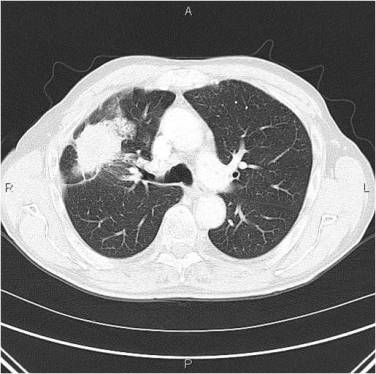
1b) Axial Image, Mediastinal Window
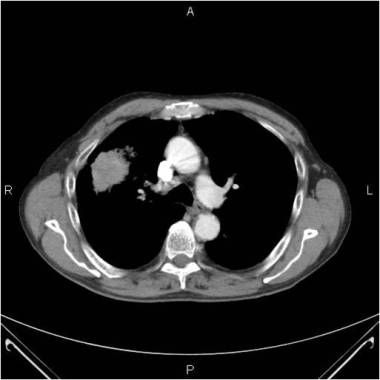
The patient only received limited chemotherapy secondary to side effects, but did receive his full course of XRT, with decrease in size of the tumor on follow up CT exams. (Not shown)
PET/CT performed in Feb. 2010 (not shown) demonstrated stable activity in the right upper lobe, and no new areas of FDG uptake.
The patient was in his usual state of health, until he began experiencing left-sided neck pain and a left sided ear ache. He went to see an ENT physician who referred him to get an MRI of his neck. (Fig. 4)
This demonstrated a 3.0 cm solid nodule within the left lobe of the thyroid. Subsequent ultrasound showed an enlarged left lobe of the thyroid, without a discrete nodule (Fig 2).
PET/CT scan demonstrated a focus of FDG uptake, localized to the left lobe of the thyroid gland, with SUV value of 9.3. (Fig. 3)
Decision was made to perform an FNA biopsy of the left thyroid, under ultrasound guidance.
Figure 2: Thyroid Ultrasound
2a) Left Lobe Saggital
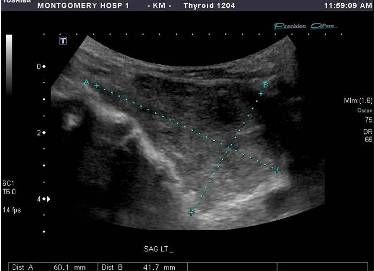
2b) Left Lobe Transverse
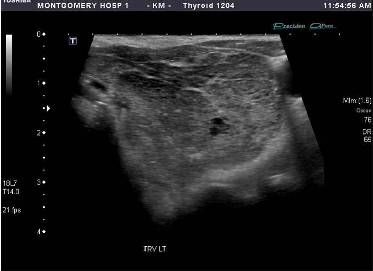
Figure 3: PET/CT
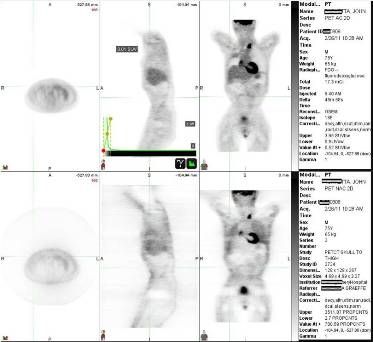
Figure 4: MRI Neck - Axial T2 weighted image at the level of the thyroid gland, demonstrates a solid nodule within the left lobe
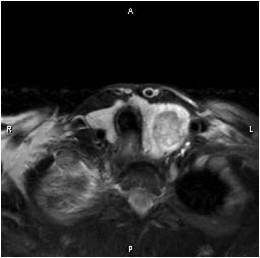
FNA Biopsy Result: Adenocarcinoma, morphologically and immunohistochemically consistent with metastasis from the patient’s known prior, poorly differentiated adenocarcinoma from 2008.
Immunohistochemical stains demonstrated: PSA-, CK7+, and TTF-1+.
Diagnosis
Adenocarcinoma of the lung with metastasis to the thyroid.
Discussion
Metastasis to the thyroid gland is rare and is found mainly in autopsy. There, incidence is reported to be from 1.25 to 24 percent. The most common malignancies include breast, lung and kidneys.
Metastasis to the thyroid accounts for 2 to 3 percent of all thyroid malignancies. Of the pulmonary malignancies, adenocarcinoma is the most common, followed by squamous and small cell.
FNA biopsy is recommended as the next diagnostic study, to confirm the clinical diagnosis, and to confirm the finding on the PET study.
Metastatic disease in the thyroid indicates a poor prognosis, especially in the case of a lung carcinoma. Average survival from the time of diagnosis to death is about two months.
References:
- Costantine A., Jain A., Ulbright T., Einhorn L. "Lung Cancer, thyroid cancer or both: An Unusual Case presentation." J Thorac Dis 2011;3.
- Singh R., Lehl A., Sachdev U., Handa S., D’Cruz S., Bhalla A., Indian J. "Metastasis to Thyroid from Lung Carcinoma; a Case Report." Chest Dis Allied Sci 2003; 45:203-204.
- WebMD
Laurence J. Spitzer, M.D., is Associate Director, Department of Radiology, Montgomery Hospital
Norristown, PA.
Study Shows No Impact of Hormone Therapy on PET/CT with 18F-Piflufolastat in PCa Imaging
May 7th 2025For patients with recurrent or metastatic prostate cancer, new research findings showed no significant difference in the sensitivity of 18F-piflufolastat PET/CT between patients on concurrent hormone therapy and those without hormone therapy.